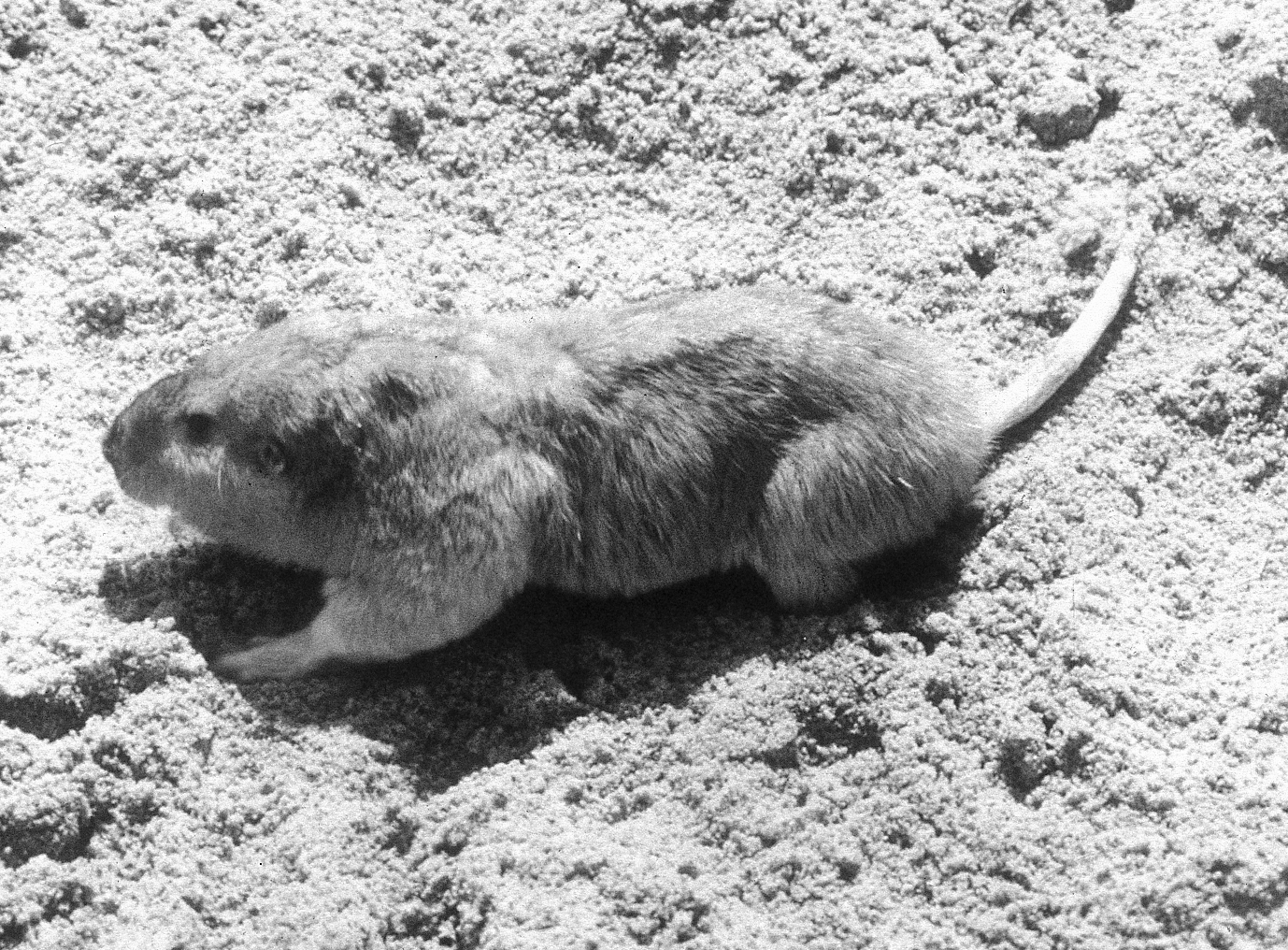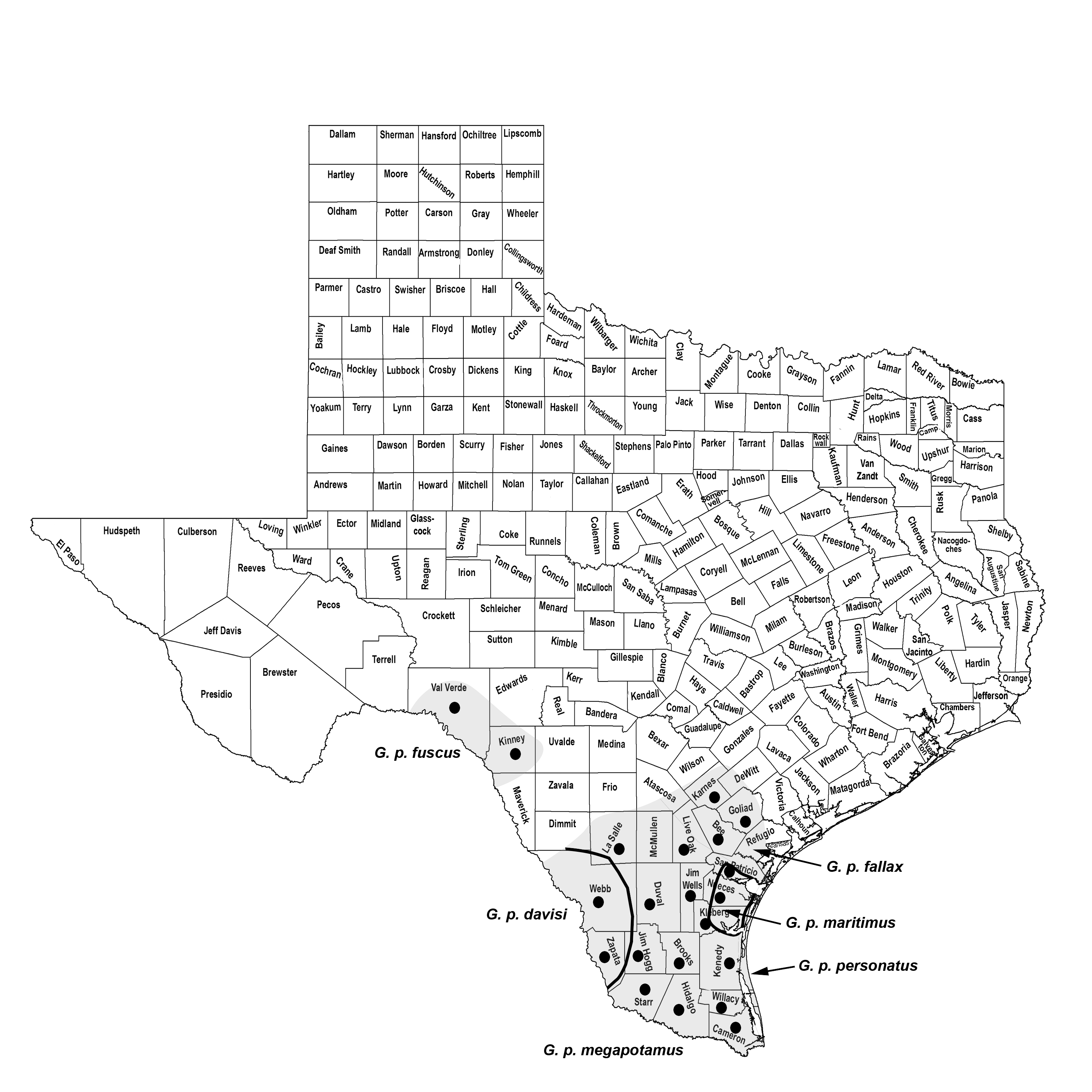TEXAS POCKET GOPHER
Geomys personatus True 1889
Order Rodentia : Family Geomyidae
DESCRIPTION. A large, pale drab or grayish drab species with relatively long, scant-haired tail, the distal half nearly naked; upper incisors with two grooves; underparts marbled white and dusky. Dental formula: I 1/1, C 0/0, Pm 1/1, M 3/3 X × 2 = 20. Averages for external measurements: of males, total length, 321 mm; tail, 110 mm; hind foot, 41 mm; of females, 303-103-39 mm. Weight, up to 400 g.

DISTRIBUTION. South Texas as far north as Val Verde County on the west and San Patricio County on the east; includes several of the barrier islands in this region.

SUBSPECIES. Six currently recognized: G. p. davisi in the Rio Grande Valley in western Webb and Zapata counties; G. p. fallax from Nueces Bay northward to Karnes County; G. p. fuscus from Kinney and Val Verde counties; G. p. maritimus in Kleberg and Nueces counties; G. p. megapotamus from La Salle County southeastward to the south side of Baffin Bay and to the Rio Grande; and G. p. personatus on Mustang and Padre Islands.
HABITS. This species occurs in deep, sandy soils. It is entirely absent from the silt loams of the floodplains of the Rio Grande and also from gravelly, stony, or clayey soils scattered throughout its general range.
Numerous burrows of these pocket gophers occur in the deep drift sands on Mustang and Padre Islands where the sand is moist enough to permit packing. Sometimes the tunnels are at the water table and the runways soppy with seepage, but most often they are about halfway between the surface and the water table 50 cm below. Excavated burrows average about 10 cm in horizontal diameter, 12.5 cm in vertical diameter, and 25 cm beneath the surface. In places where the sand is drier, yet still moist enough to maintain a burrow, the tunnels are about 12 × 15 cm in diameter. In the soils near Robs-town, Texas, the burrows ranged from 6 to 8 cm in diameter. One partially excavated burrow system on Padre Island was >30 m (98 ft.) long. There were numerous short side branches, but no food cache or chamber for fecal pellets, which are usual in burrows of Geomys, were identified. Another burrow excavated on the mainland contained a food cache of Bermuda grass. The average mounds are large; a typical one might measure 45 × 60 cm in horizontal diameter and 12 cm in height and could contain almost 6 kg of sand.
These pocket gophers are ferocious and aggressive. When disturbed they emit a wheezy call at frequent intervals and gnash their teeth.
Their food consists largely of vegetation. Known items include roots of grasses (Paspalum, Cynodon, and Cenchrus) and the roots, stems, and leaves of a composite (Helianthus). Most of their foraging is done underground; the plants often are seized from below and pulled into the burrow. Their feces are capsule shaped and about 19 mm in length and 7 mm in diameter. Individuals of this species, as well as other Geomys, have the interesting habit of ingesting their own fecal pellets. A fecal pellet is taken in the incisors directly from the anus, examined and manipulated with the aid of the forefeet, and then either discarded or thoroughly chewed and swallowed. Usually two to four pellets are produced at a time, with only one or two being eaten, often none. There appears to be no pattern as to which pellet or pellets are eaten. Production of fecal pellets often occurs in the nest, in which case the rejected pellets are simply pushed out into the adjoining tunnel. Pocket gophers may also stop their travels through the burrow system to defecate, again either discarding or eating the pellets after examining each one carefully. Captive individuals have been seen to interrupt a meal of grass, potatoes, or other food to defecate and then consume one or more fecal pellets. This behavior is well documented for many species of rabbits and rodents and may serve to extract maximum sustenance from ingested plant foods.
Their breeding habits are not well known. Pregnant females have been captured in December–March, May, July, October, and November, suggesting that breeding may occur year-round. Young gophers about one-fourth grown were trapped in early April. Litter size ranges from one to five, averaging three. Probably no more than two litters are reared yearly.
In southern Texas, these pocket gophers have little economic importance except in cultivated fields or where they become established along the highways. Along highways they may undermine the shoulders and initiate erosion.
POPULATION STATUS. Common. The Texas pocket gopher is common throughout most of its range; however, populations occurring on the coast or barrier islands have been declining in recent years and are threatened by human activities.
CONSERVATION STATUS. The IUCN lists the Texas pocket gopher as a species of least concern, and it does not appear on the federal or state lists of concerned species. One of the subspecies of the Texas pocket gopher bears watching. Geomys p. maritimus is known only from its type locality at Flour Bluff, near Corpus Christi, in Kleberg County. Given that this locality is within the greater Corpus Christi metropolitan area, it obviously could be threatened by urbanization. Other populations of this pocket gopher appear to be in good standing, although increased urbanization and development along the coastal areas may negatively impact populations.
From The Mammals of Texas, Seventh Edition by David J. Schmidly and Robert D. Bradley, copyright © 1994, 2004, 2016. Courtesy of the University of Texas Press.
Natural Science Research Laboratory
-
Address
Museum of Texas Tech University, 3301 4th street, Lubbock, TX 79409 -
Phone
806.742.2486 -
Email
nsrl.museum@ttu.edu

